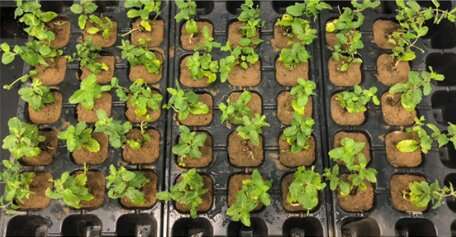Plants absorb lead from perovskite solar cells more than expected

Lead from metal-organic perovskite compounds can be absorbed particularly easily by plants. The bioavailability is significantly higher than that of lead from inorganic compounds, as found in batteries. This is shown in a study by HZB researcher Antonio Abate with partners in China and Italy, published in Nature Communications.
Certain perovskite compounds are candidates for better and cheaper solar cells. Their crystal lattice is formed by organic methylammonium cations (MA+) surrounded by heavy metal atoms (lead or tin) and atoms like iodine. The best perovskite solar cells today are realized with lead. In just 10 years of research, the efficiency of these solar cells in the laboratory has been increased from 4 percent (2009) to over 25 percent (2019). However, lead is toxic and must not enter the food chain. On the other hand, very little lead is needed for a solar module: a square meter perovskite solar module contains only 0.8 grams of lead, which is very little compared to other technical sources of lead (e.g., in batteries).
Now, a team led by Prof. Antonio Abate at the Helmholtz-Zentrum Berlin has designed a study to investigate this risk. They cooperated with plant scientists from the Fujian Agriculture and Forestry University, China, where the experiments were carried out, and with a group from the university of Naples, Italy.
The plant experts prepared contaminated soil samples with different concentrations of lead from either perovskite solar cells or other lead sources and cultivated different plants. After a growth period, they analyzed the lead content in leaves and other parts of the plant. They found that lead from perovskite solar cells is 10 times more bioavailable than lead from other industrial sources.
"And what's more, the uptake ability of lead increases with the concentration of perovskite in the soil," says Dr. Qiong Wang from Abate's team. This could be related to the fact that the organic cations in the perovskite change the PH content of the soil and thus promote the absorption of lead by the plants, she suggests. "These results show that we cannot consider perovskite as just another lead contaminant," Abate concludes.
Abate is working on the development of lead-free perovskite solar cells containing tin. Tin is also highly toxic, although it reacts very quickly to non-water-soluble forms. A series of experiments with mint plants on tin-contaminated soil showed that the plants absorb only a small amount of it. Lead-free perovskite solar cells, however, still fall short of the high efficiencies of lead-containing solar cells, and also have even greater problems with stability.
The Helmholtz-Zentrum Berlin has expertise in the field of perovskite solar cells with or without lead. "We have to investigate this class of materials very broadly," Abate says: "Of course, it is important to increase efficiencies and longtime stability, but we need as well to make sure that these materials do not pose a risk for the environment."
More information: We should be worried about lead in halide perovskites, Nature Communications (2020). DOI: 10.1038/s41467-019-13910-y , nature.com/articles/s41467-019-13910-y
Journal information: Nature Communications
Provided by Helmholtz Association of German Research Centres





















